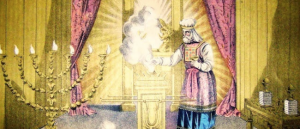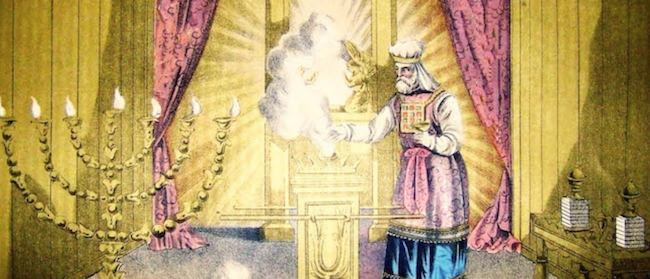
Aharon shall enter the Holy with this: with a young bull for a sin offering and a ram for a burnt offering. (Vayikra 16:3)
THE SUSPENSE IS killing me!” Zevulun told his friend Naphtali. “It seems like he’s been in there forever!”
Naphtali smiled. “Patience has never been your strong point,” he told his friend of many years.
“You’re not nervous, not even a little bit?”
Naphtali thought before he answered. Sure, he was nervous, but there would be plenty of time to panic if the outcome were not good. In the meantime, he chose to remain calm, and that is what he told his friend.
A few more “eternal” minutes passed, and then they finally heard a commotion. It built quickly until they could clearly hear the words, “He’s OUT! The Kohen Gadol is out of the Kodesh Kodashim!”
Instantly, the mood changed. Pensive faces became filled with joy. People surged forward to try to escort the Kohen Gadol back to his home. He had done his job and he had done it well. The nation had divine forgiveness, and had survived another Yom Kippur. It was the happiest moment of the year!
“This is the end of a long process,” Naphtali told Zevulun, after they returned to Zevulun’s home an hour later.
“I know that,” Zevulun said. “Seven days ago, the Kohen Gadol was sequestered in the Palhedrin Chamber in the Bais HaMikdash. That’s when he reviewed the service with the chachamim. He was also sprinkled with spring water containing ashes of the Red Heifer, and he practiced the incense-offering ritual in the Avitnas Chamber.”
“Good for you,” Naphtali said, “you’ve learned your mishnayos well!”
“I sure did, and I’m not done yet. On Yom Kippur itself, the Kohen Gadol had to follow a precise order of services, sacrifices, and purifications, but for that I have to refer to my notes.”
Zevulun looked around, and then saw what he was looking for on a small shelf in the corner. He walked over, took a small scroll of parchment from the shelf, and began to unroll it.
His family had a modest home, and in those days they still had dirt floors. There were a few pieces of homemade furniture, and that was it. It was all people expected in Temple times, and it was enough.
Zevulun continued. “First the Kohen Gadol offered the regular daily offering…”
“The Tamid,” Naphtali inserted.
“Right, the Tamid,” Zevulun confirmed. “It was usually performed by ordinary kohanim, but on Yom Kippur the Kohen Gadol offered it, wearing special golden garments that he put on after immersing in a mikvah and washing his hands and feet. After that, he immersed again in a special mikvah in the Temple courtyard, again washing his hands and feet, and changed into special linen garments. Thus he immersed and washed his hands and feet twice, both before putting on the golden garments and before putting on the linen garments.”
“I’m exhausted just thinking about everything he had to do until this point!” Naphtali said, feigning exhaustion.
“Yeah, well, it was far from over. Next came the his personal sin-offering, a bull. The Kohen Gadol leaned on it and made a confession on behalf of himself and his household, pronouncing the Tetragrammaton. All the people who heard it prostrated themselves…”
“That is AWESOME!” Naphtali interjected.
“It WAS…IS…” Zevulun agreed, looking up from the scroll he held between his hands. “Perhaps one day WE will merit to be one of those fortunate people!”
“Then the Kohen Gadol slaughtered the bull as a sin-offering,” he said returning to his scroll, “and received its blood in a bowl.”
He looked up at Naphtali again to see if he still had his interest. The fascinated look on his face indicated that he did, so he continued.
“Next came the goral—lottery of the goats. At the Nikanor Gate, the Kohen Gadol drew lots from a lottery box for two identical goats. One was selected ‘for God,’ and one ‘for Azazel.’”
“My father told me a little bit about the mystery of Azazel.” Naphtali cut in.
Zevulun looked up and said, “I’m all ears! I’ve wondered about this part of the service for a while now.”
“If I remember correctly, it has to do with giving the Satan his due. Everything in Creation survives because of the light of God, even evil. Creation was made for free will, and free will requires that good AND evil exist. So God maintains evil with a specific number of holy sparks to keep it going—but only enough to TEST us, not OVERWHELM us. When we sin, we ‘feed’ it extra holy sparks, making it stronger and far more destructive.”
“Hmm,” Zevulun said, mournfully. “We’ve seen just HOW true that is…”
“Unfortunately yes,” Naphtali agreed, and then added, “Pushing the goat off the cliff may look barbaric, especially to a spiritual entity like the Sitra Achra, but every PHYSICAL act has SPIRITUAL ramifications. THIS act is like throwing a bone to a dog, because when we give the Sitra Achra his due, he gets off OUR case…”
“And that means fewer accusations against the Jewish people,” Zevulun interjected.
“Hence the forgiveness power of Yom Kippur,” Naphtali completed.
Zevulun considered the idea. “Good explanation,” he said, and then returned to his scroll and explanation.
“The Kohen Gadol tied a red band around the horns of the goat ‘for Azazel,’ which turns white if the Jewish people are forgiven…”
“As happened this year, thank God!” Naphtali said.”
Zevulun glanced through his scroll until the end and, realizing that he had more material to share than he had time—and perhaps even patience—to do in one sitting, he decided to go into overview mode instead.
“There’s still a fair bit to go over,” he told Naphtali.
“Why don’t you just cover the most basic details? We can fill in the gaps later,” Naphtali suggested.
“My plan exactly,” Zevulun said. “Yom Kippur is coming to an end…”
He opened the scroll wider in order to increase his view of the main headings. He said, “Next came the incense preparation. The Kohen Gadol took a shovel full of embers with a special shovel from the altar. He filled his hands with the incense and placed it in a vessel.”
“Some say this is the most physically difficult part of the service,” Naphtali interjected, “because the Kohen Gadol has to keep the shovelful of glowing coals balanced, using his armpit or teeth, while filling his hands with the incense.”
“Right. And then, holding the shovel and the vessel, he enters the Kodesh Kodashim and places the shovel between the poles of the Ark.”
“Next?” Naphtali prompted.
“Next was the sprinkling of bull’s blood in the Holy of Holies…the goat for God as a sin-offering for kohanim. The blood of the goat was sprinkled in the Kodesh Kodashim.”
“Good…” Naphtali said approvingly. “I’m impressed that you covered all this.”
Zevulun just smiled as he spoke. “This was followed by the sprinkling of blood in the Kodesh, on the other side of the Paroches. The Kohen Gadol took the bull’s blood from the stand and sprinkled it with his finger eight times in the direction of the Paroches. He then took the bowl with the goat’s blood and sprinkled it eight times in the same manner, putting it back on the stand.”
Naphtali could see that Zevulun was becoming faint from the fast. “Why don’t you take a break for a few minutes,” he said, “and let me do the talking.”
Zevulun hesitated, but then he felt the full impact of expending so much energy on a fast day. He said, “Good idea,” and handed the scroll to Naphtali, showing him where he had left off. Naphtali began to read.
“You have here that next was the smearing of blood on the Golden Incense Altar. The Kohen Gadol removed the goat’s blood from the stand and mixed it with the bull’s blood. Starting at the northeast corner, he then smeared the mixture of blood on each of the four corners of the altar in the Heichal. After that, he sprinkled the blood eight times on the altar.”
“The Kohen Gadol left the Heichal and walked to the east side of the Azarah. Near the Nikanor Gate, he leaned his hands on the goat ‘for Azazel’ and confessed the sins of the entire people of Israel. The people prostrated themselves when he pronounced the Tetragrammaton. While he made a general confession, individuals in the crowd at the Temple would confess privately. The Kohen Gadol then sent the goat off to the wilderness. The goat was led to a cliff outside Jerusalem and pushed off its edge.”
“While the goat for Azazel was being led to the cliff, the Kohen Gadol removed the insides of the bull, and intertwined the bodies of the bull and goat. Others took the bodies to the ‘Place of the Ashes,’ where they were burned after it was confirmed that the goat for Azazel had reached the wilderness.”
“After it was confirmed that the goat had been pushed off the cliff, the Kohen Gadol passed through the Nikanor Gate into the Ezras Nashim and read sections of the Torah describing Yom Kippur and its sacrifices.”
Zevulun just kept nodding his head at different places as if to confirm the details being read. Naphtali continued.
“The Kohen Gadol removed his linen garments, immersed in the mikvah in the Temple courtyard, and changed into a second set of special golden garments. He washed his hands and feet both before removing the linen garments and after putting on the golden ones…”
Now it was Naphtali’s turn to feel weak. He paused, took a breath, and looked at Zevulun.
“Perhaps,” Zevulun suggested, “we should go over the rest of the service after we have eaten and regained our strength!”
“Timely suggestion,” Naphtali agreed, rolling up the scroll and handing it to Zevulun.
True to their word, the next day on full stomachs they finished what they had started. They covered the two rams of an olah offering, the mussaf offering, the burning of innards of the bull and goat on the outer altar, the third garment change, the removal of the incense from the Holy of Holies, the fourth garment change, and finally the afternoon continual offering.
“What a day that must have been for the Kohen Gadol!” Zevulun concluded.
“For sure,” Naphtali agreed. “The Kohen Gadol wore five sets of garments, immersed in the mikvah five times, and washed his hands and feet ten times. The sacrifices included two daily lambs, one bull, two goats, and two rams, with accompanying minchah offerings, wine libations, and three incense offerings. He entered the Holy of Holies three times and he pronounced the Tetragrammaton three times, once for each confession.”
“It must have taken a lot of stamina,” Zevulun mused.
“And fear of God,” Naphtali added.
“Fear of God and physical stamina…” Zevulun said. “That’s a great combination to have if you’re the Kohen Gadol…”
“Or just a good Jew!” Naphtali threw in.
“Or just a good Jew,” Zevulun agreed.


